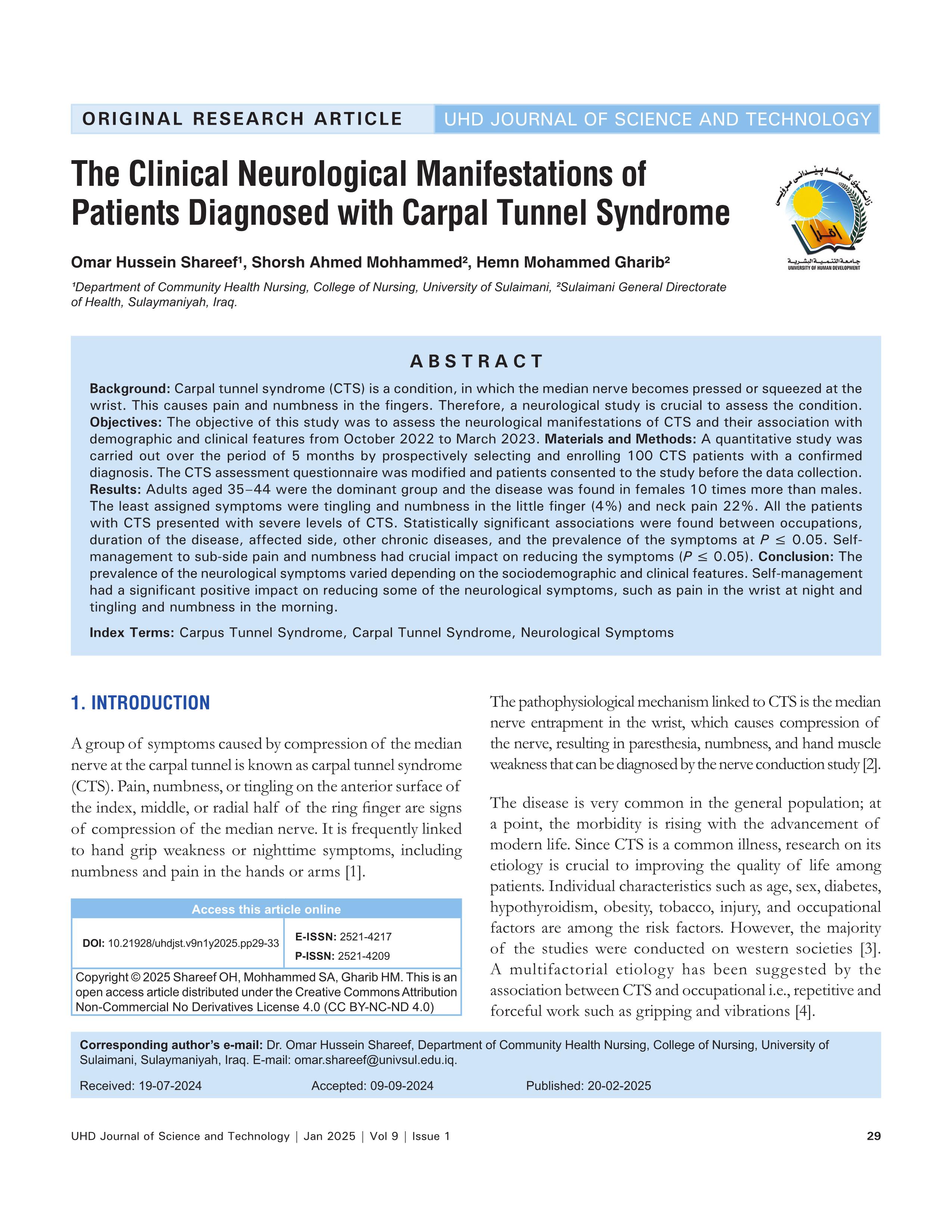The Clinical Neurological Manifestations of Patients Diagnosed with Carpal Tunnel Syndrome
DOI:
https://doi.org/10.21928/uhdjst.v9n1y2025.pp29-33Keywords:
Carpus Tunnel Syndrome, Carpal Tunnel Syndrome, Neurological SymptomsAbstract
Background: Carpal tunnel syndrome (CTS) is a condition, in which the median nerve becomes pressed or squeezed at the wrist. This causes pain and numbness in the fingers. Therefore, a neurological study is crucial to assess the condition.Objectives: The objective of this study was to assess the neurological manifestations of CTS and their association with demographic and clinical features from October 2022 to March 2023. Materials and Methods: A quantitative study was carried out over the period of 5 months by prospectively selecting and enrolling 100 CTS patients with a confirmed diagnosis. The CTS assessment questionnaire was modified and patients consented to the study before the data collection. Results: Adults aged 35–44 were the dominant group and the disease was found in females 10 times more than males. The least assigned symptoms were tingling and numbness in the little finger (4%) and neck pain 22%. All the patients with CTS presented with severe levels of CTS. Statistically significant associations were found between occupations, duration of the disease, affected side, other chronic diseases, and the prevalence of the symptoms at P ≤ 0.05. Self-management to sub-side pain and numbness had crucial impact on reducing the symptoms (P ≤ 0.05). Conclusion: The prevalence of the neurological symptoms varied depending on the sociodemographic and clinical features. Self-management had a significant positive impact on reducing some of the neurological symptoms, such as pain in the wrist at night and tingling and numbness in the morning.
References
C. F. De-Las Peñas, R. Ortega-Santiago, A. I. de la Llave-Rincón, A. Martínez-Perez, H. F. S. Díaz, J. Martínez-Martín, J. A. Pareja and M. L. Cuadrado-Pérez. “Manual physical therapy versus surgery for carpal tunnel syndrome: A randomized parallel-group trial”. The Journal of Pain, vol. 16, no. 11, pp. 1087-1094, 2015.
P. K. Srikanteswara, J. D. Cheluvaiah, J. B. Agadi and K. Nagaraj. “The relationship between nerve conduction study and clinical grading of carpal tunnel syndrome”. Journal of Clinical and Diagnostic Research, vol. 10, pp. 13-18, 2016.
M. Sonohata, T. Tsuruta, H. Mine, A. Asami, H. Ishii, K. Tsunoda and M. Mawatari. “The effect of carpal tunnel release on neuropathic pain in carpal tunnel syndrome”. Pain Research and Management, vol. 2017, p. 8098473, 2017.
M. Riccò, S. Cattani and C. Signorelli. “Personal risk factors for carpal tunnel syndrome in female visual display unit workers”. International Journal of Occupational Medicine and Environmental Health, vol. 29, no. 6, pp. 927-936, 2016.
G. Ntani, K. T. Palmer, C. Linaker, E. Clare Harris, R. Van der Star, C. Cooper and D. Coggon. “Symptoms, signs and nerve conduction velocities in patients with suspected carpal tunnel syndrome”. BMC Musculoskeletal Disorders, vol. 14, p. 242, 2013.
T. Koukoulaki. “The impact of lean production on musculoskeletal and psychosocial risks: An examination of sociotechnical trends over 20 years”. Applied Ergonomics, vol. 45, no. 2, pp. 198-212, 2014.
A. Dabbagh, J. C. Macdermid, J. Yong, L. G. Macedo and T. L. Packham. “Diagnosing carpal tunnel syndrome: Diagnostic test accuracy of scales, questionnaires, and hand symptom diagrams-a systematic review”. Journal of Orthopaedic and Sports Physical Therapy, vol. 50, no. 11, pp. 622-631, 2020.
J. Hong, X. Wang, J. Xue, J. Li, M. Zhang and W. Mao. “Clinical characteristics and treatment of adult idiopathic carpal tunnel syndrome accompanied with trigger digit”. Computational and Mathematical Methods in Medicine, vol. 2022, p. 8104345, 2022.
K. Möllestam, M. Englund and I. Atroshi. “Association of clinically relevant carpal tunnel syndrome with type of work and level of education: A general-population study”. Scientific Reports, vol. 11, no. 1, p. 19850, 2021.
B. Feng, K. Chen, X. Zhu, W. Y. Ip, L. L. Andersen, P. Page and Y. Wang. “Prevalence and risk factors of self-reported wrist and hand symptoms and clinically confirmed carpal tunnel syndrome among office workers in China: A cross-sectional study”. BMC Public Health, vol. 21, no. 1, p. 57, 2021.
S. Kumar and M. Muralidhar. “Analysis for prevalence of carpal tunnel syndrome in shocker manufacturing workers”. Advances in Production Engineering and Management, vol. 11, no. 2, pp. 126- 140, 2016.
H. C. Tang, Y. Y. Cheng and H. R. Guo. “Association between hormone replacement therapy and carpal tunnel syndrome: A nationwide population-based study”. BMJ Open, vol. 12, no. 1, p. e055139, 2022.
B. Evanoff, B. T. Gardner, J. R. Strickland, S. Buckner-Petty, A. Franzblau and A. M. Dale. “Long-term symptomatic, functional, and work outcomes of carpal tunnel syndrome among construction workers”. American Journal of Industrial Medicine, vol. 59, no. 5, pp. 357-368, 2016.
F. Sharief, J. Kanmani and S. Kumar. “Risk factors, symptom severity and functional status among patients with carpel tunnel syndrome”. Neurology India, vol. 66, no. 3, pp. 743-746, 2018.
Y. H. Shin, J. O. Yoon, Y. K. Kim and J. K. Kim. “Psychological status is associated with symptom severity in patients with carpal tunnel syndrome”. The Journal of Hand Surgery, vol. 43, no. 5, pp. 484.e1-484.e8, 2018.
S. Eslami, B. Fadaei, M. Baniasadi and P. Yavari. “Clinical presentation of carpal tunnel syndrome with different severity: A cross sectional study”. American Journal of Clinical and Experimental Immunology, vol. 8, no. 4, pp. 32-36, 2019.

Downloads
Published
How to Cite
Issue
Section
License
Copyright (c) 2025 Omar Hussein Shareef, Shorsh Ahmed Mohammed, Hemn Mohammed Gharib

This work is licensed under a Creative Commons Attribution-NonCommercial-NoDerivatives 4.0 International License.


